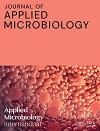Latest Publications
Coevolutionary analysis of Pseudomonas syringae–phage interactions to help with rational design of phage treatments
 Mojgan Rabiey, Emily R. Grace, Paulina Pawlos, Muscab Bihi, Haleem Ahmed, Georgina E. Hampson, Amna Al Riyami, Leena Alharbi, Rosa Sanchez-Lucas, Naina Korotania, Maria Laura Ciusa, Olivia Mosley, Michelle T. Hulin, Laura Baxter, Sabrine Dhaouadi, Diana Vinchira-Villarraga, Robert W. Jacks
Mojgan Rabiey, Emily R. Grace, Paulina Pawlos, Muscab Bihi, Haleem Ahmed, Georgina E. Hampson, Amna Al Riyami, Leena Alharbi, Rosa Sanchez-Lucas, Naina Korotania, Maria Laura Ciusa, Olivia Mosley, Michelle T. Hulin, Laura Baxter, Sabrine Dhaouadi, Diana Vinchira-Villarraga, Robert W. Jacks
Pseudomonas syringae pathovar syringae (Pss) is a major pathogen of cherry (Prunus avium) causing bacterial canker of the stem, leaf and fruit, impacting productivity and leading to a loss of trees. In an attempt to find a treatment for this disease, naturally occurring bacteriophage (phage) that specifically target Pss is being investigated as a biocontrol strategy. However, before using them as a biocontrol treatment, it is important to both understand their efficacy in reducing the bacterial population and determine if the bacterial pathogens can evolve resistance to evade phage infection. To investigate this, killing curve assays of five MR phages targeting Pss showed that phage resistance rapidly emerges in vitro, even when using a cocktail of the five phages together. This study shows that understanding the genetic mechanisms of bacterial pathogen resistance to phages is important for helping to design a more effective approach to kill the bacteria while minimizing the opportunity for phage resistance to manifest.
A climatic suitability indicator to support Leishmania infantum surveillance in Europe : a modelling study
 Carvalho, Bruno M., Maia, Carla, Courtenay, Orin, Llabrés-Brustenga, Alba, Lotto Batista, Martín, Moirano, Giovenale, van Daalen, Kim R., Semenza, Jan C. and Lowe, Rachel
Carvalho, Bruno M., Maia, Carla, Courtenay, Orin, Llabrés-Brustenga, Alba, Lotto Batista, Martín, Moirano, Giovenale, van Daalen, Kim R., Semenza, Jan C. and Lowe, Rachel
Leishmaniases are neglected diseases transmitted by sand flies. The aim of this modelling study was to develop an indicator that tracks climatic suitability for Leishmania infantum transmission in Europe at the subnational level. Historical records of sand fly vectors, human leishmaniasis, bioclimatic indicators, and environmental variables were integrated in a machine learning framework (XGBoost) to predict suitability in two past periods (2001–2010 and 2011–2020. This study demonstrates how key epidemiological data can be combined with open-source climatic and environmental information to develop an indicator that effectively tracks spatiotemporal changes in climatic suitability and disease risk. The positive association between the model predictions and human disease incidence demonstrates that this indicator could help target leishmaniasis surveillance to transmission hotspots.
Phenotypic and genotypic characterization of fifty strains of Beauveria spp. (Ascomycota, Cordycipitaceae) fungal entomopathogens from diverse geographic origins against the diamondback moth, Plutella xylostella (Lepidoptera: Plutellidae)
 Laura Reyes-Haro, Gillian Prince, Rommel Santiago Granja-Travez, David Chandler
Laura Reyes-Haro, Gillian Prince, Rommel Santiago Granja-Travez, David Chandler
The diamondback moth (DBM) (Plutella xylostella) causes large losses to global crop production. Conventional insecticides are losing effectiveness due to resistance. Consequently, there is a growing interest in sustainable control methods like entomopathogenic fungi (EPF) in Integrated Pest Management. However, the field efficacy of fungi varies due to environmental influences. In this study, a group of 50 Beauveria strains sourced from different locations were characterized by genotype and phenotype with respect to their conidial production, temperature and UV-B radiation tolerance, and virulence against DBM. Survival under environmental conditions is crucial for EPF-based commercial products against DBM. Results suggest strain tolerance to environmental stressors is more tied to specific micro-climatic factors than geographical origin. Each strain exhibited unique characteristics; for example, the most virulent strain (#29) was highly UV-sensitive. Therefore, characterizing diverse strains provides essential genotypic and phenotypic insights, which are fundamental for understanding their role as biocontrol agents while facilitating efficient biopesticide product development and uptake
Mitochondrial and microbial diversity of the invasive mosquito vector species Culex tritaeniorhynchus across its extensive inter-continental geographic range
 Claire L. Jeffries, Luciano M Tantely, Perparim Kadriaj, Marcus S C Blagrove, Ioanna Lytra, James Orsborne, Hasan Mohammad Al-Amin, Abdul Rahim Mohammed, Mohammad Shafiul Alam, Romain Girod, Yaw A Afrane, Silvia Bino, Vincent Robert, Sebastien Boyer, Matthew Baylis, Enkelejda Velo, Grant L Hughes, Thomas Walker
Claire L. Jeffries, Luciano M Tantely, Perparim Kadriaj, Marcus S C Blagrove, Ioanna Lytra, James Orsborne, Hasan Mohammad Al-Amin, Abdul Rahim Mohammed, Mohammad Shafiul Alam, Romain Girod, Yaw A Afrane, Silvia Bino, Vincent Robert, Sebastien Boyer, Matthew Baylis, Enkelejda Velo, Grant L Hughes, Thomas Walker
In this study, we used laboratory vector competence experiments to determine if Cx. tritaeniorhynchus from a Southern European population were competent JEV vectors. We obtained samples from multiple geographically dispersed Cx. tritaeniorhynchus populations from countries within Europe, Africa, Eurasia and Asia to perform phylogenetic analysis to measure the level of mitochondrial divergence using the cytochrome oxidase subunit 1 (CO1) gene. We also undertook bacterial 16S rRNA gene amplicon sequencing to determine microbial diversity and used multi-locus sequence typing (MLST) to determine any evidence for the presence of strains of the naturally occurring endosymbiotic bacterium Wolbachia. Cx. tritaeniorhynchus from a Greek population were shown be be competent vectors of JEV with high levels of virus present in saliva. We found a signficant level of mitochondrial genetic diversity using the mosquito CO1 gene between geographically dispersed populations. Furthermore, we report diverse microbiomes identified by 16S rRNA gene amplicon sequencing within and between geographical populations. Evidence for the detection of the endosymbiotic bacteria Wolbachia was confirmed using Wolbachia-specific PCR and MLST.
Response patterns of the microbiome during hexavalent chromium remediation by Tagetes erecta L
 Juanjuan Xiao, Deying Wang, Banerjee Sinchan, Ryan Mushinski, Decai Jin, Ye Deng
Juanjuan Xiao, Deying Wang, Banerjee Sinchan, Ryan Mushinski, Decai Jin, Ye Deng
Chromium pollution, particularly hexavalent chromium [Cr(VI)], may threaten the environment and human health. This study investigated the potential of Tagetes erecta L. (Aztec marigold) for phytoremediation of soil contaminated with Cr(VI), and focused on the effects of varying concentrations of Cr(VI) on both the physicochemical properties of soil and microbiome of Tagetes erecta L. We observed that Tagetes erecta L. showed tolerance to Cr(VI) stress and maintained normal growth under these conditions, as indicated by bioconcentration factors of 0.33–0.53 in shoots and 0.39–0.70 in roots. Meanwhile, the structure and diversity of bacterial communities were significantly affected by Cr(VI) pollution. This study explored the interactions between heavy metals, microorganisms, and plants, providing valuable insights for developing in situ bioremediation of Cr(VI)-contaminated soils.
Unveiling novel Neocosmospora species from Thai mangroves as potent biocontrol agents against Colletotrichum species
 Klomchit, A, Calabon, MS, Worabandit, S, Weaver, JA, Karima, EM, Alberti, F, Greco, C and Mahanil, S
Klomchit, A, Calabon, MS, Worabandit, S, Weaver, JA, Karima, EM, Alberti, F, Greco, C and Mahanil, S
This study aims to investigate the taxonomy, biosynthetic potential, and application of three newly isolated Neocosmospora species from mangrove habitats in the southern part of Thailand using phylogeny, bioactivity screening, genome sequencing, and bioinformatics analysis.
Two fungal isolates of Neocosmospora and a new species of N. mangrovei were reported in this study. These fungal strains showed activity against pathogenic fungi causing anthracnose in chili. In addition, full genome sequencing and bioinformatics analysis of N. mangrovei MFLUCC 17–0253 were obtained.
